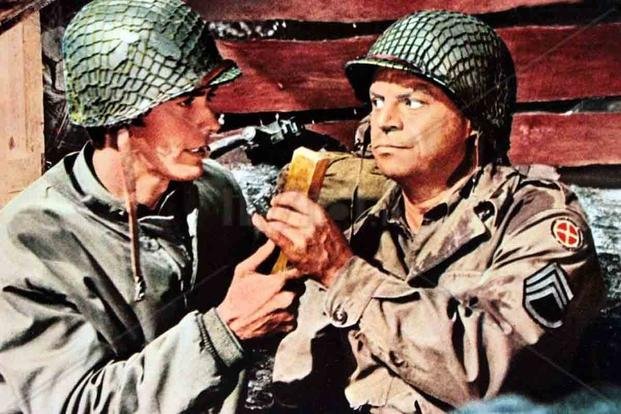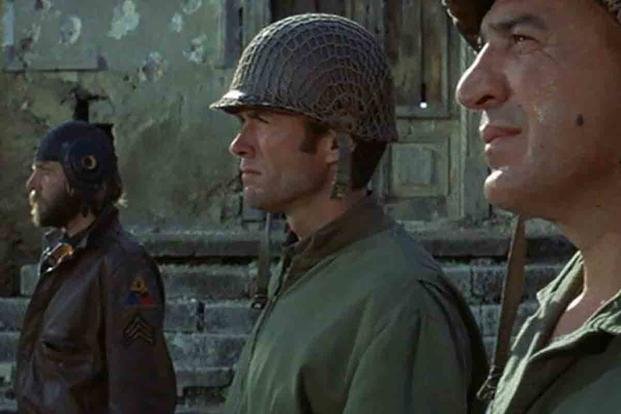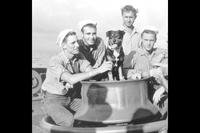“Kelly’s Heroes” is a war movie like no other. The 1970 film is set in World War II Europe and features a group of ne'er-do-wells who learn about a cache of stolen Nazi gold behind enemy lines and form a mission to get it for themselves.
Not only was the gold far behind enemy lines, the Germans were in the process of making a big push against the Allies while supply problems stalled the push into Europe. The gold was also in a locked bank, guarded by a team of Tiger tanks. It’s not really a spoiler to reveal that Kelly’s makeshift platoon gets the gold in the end -- but it might be a surprise to learn the heist was based in reality.
Screenwriter Troy Kennedy Martin first learned about the real-life gold heist in an entry titled “The Greatest Robbery on Record” in the “Guinness World Records” book. In the real world, the gold wasn’t just a bunch of Nazi loot; it was the German National Gold Reserve.

On Feb. 3, 1945, a massive Allied air campaign over Berlin wrecked much of the city’s important government fixtures. Among them was the Reichsbank, where Nazi Germany stored its gold reserves. Some 950 bombers flattened the German capital, exposing the bank’s vault.
Its valuable contents were left intact, but would not survive another raid like the one on Feb. 3. The vault contained Germany’s gold reserves, as well as those looted from Czechoslovakia, Austria, Hungary, Albania, Belgium, Italy, Holland and the Soviet Union. In all, there was more than $21 billion (in 2021 dollars) in the German Reichsbank.
Not all of it was in Berlin that day, but there was enough of it that the German government was compelled to move the gold to a potassium mine in Merkers, Germany, for safekeeping. Also in the mine were Germany’s paper currency reserves, pilfered works of art, stolen gold and silver from death-camp victims, and the captured currency from other nations.
Then, Gen. George Patton’s Third Army launched a surprise attack that tore through the Nazi defenses. Before his forces captured Merkers and the money hidden in the mines, the Germans moved some of the contents, but much of it was captured by the Americans and moved to Frankfurt.
That wasn’t all of Germany’s gold bullion, however. What was left of the Reichsbank reserves were spread out in branches across Germany. The German south became the repository of the rest of the Nazi gold, hidden away in mines, houses and mountains, just to name a few places. An estimated $151 million was sent to Bavaria, specifically the Alpine resort town of Mittenwald, where it eventually was hidden away in a remote mountain lodge.
The Americans knew the currency and gold were in the area and were looking for it. Two German officers took charge of clandestinely moving the reserves little by little and reburying it in an area adjacent to a friendly alpine lodge. The Americans soon discovered the cache through the help of captured internees and two German informants. The gold was buried in the mountains near Lake Walchen under a false tree stump and was discovered by U.S. armored engineers -- nine tons of it, 728 bars worth $15,000 each. They took the gold to a depository at the Reichsbank building in Frankfurt.
But 25 crates of 100 gold bars each still were missing. They were not among the 728 dug up in the mountains. Most of the answers regarding the missing gold came from Sgt. Albert Singleton, 10th Armored Division’s provost marshal of the Mittenwald area after the war.
Singleton’s commander, a Capt. Craig, told him that he received orders for the provost marshal to take a couple of guards and a half track into the mountains with some former German officers to find a load of gold buried there. Two American intelligence officers from the Office of Strategic Services met them on the road to the pass with two 2.5-ton trucks.
The OSS agents led the group to a creek and a steep incline in the mountains that leveled off at a certain point. There, they found a trap door that led to a 12-square-foot bunker filled with gold bars. They removed the gold and slid it down the mountain rather than carry it (to prevent injuries). They put the gold in bags and loaded them onto the trucks provided by the OSS.
The next day, Singleton received a telegram from divisional headquarters, saying the gold arrived in Munich. It was just another day in the life of the provost marshal. He remembers because he sent his wife a letter describing the gold, along with a photo he’d taken at the bunker. But Singleton swore his account and the account of the 728 captured bars are different caches.
In fact, all descriptions of the two gold sites differ, from the level of inclines to the presence of a creek and the absence of a trail at the Singleton site. Singleton doesn’t even recognize anyone in the photos taken at the first cache.
And not only does Singleton’s photo back up his memory, there’s no record of the order Capt. Craig received about picking up the gold. The only physical evidence is the telegram he received after the deed had been done, but the gold loaded onto the two OSS trucks never was registered in Munich.
Some 25 boxes of gold bullion, 1.25 tons, disappeared into thin air. It never was recovered, and there are no leads as to where it might have vanished.

The myth of the missing Nazi gold actually was mistaken for the original 728 bars that ended up in Frankfurt, but the 100 boxes faded from memory as fast as they were uncovered in the mountains. It wasn’t until 1957 that any missing gold entered the public consciousness, when it appeared in the “Guinness World Records” book under the heading “Robbery: Biggest Unsolved.” It read:
“The greatest robbery on record was of the German National Gold Reserves in Bavaria by a combine of US Military personnel and German civilians in June 1945, A total of 730 gold bars valued at £3,528,000 together with six sacks of banks notes and 25 boxes of platinum bars and precious stones disappeared in transit but none of those responsible has been brought to trial.”
It was this entry that inspired British film and television writer Troy Kennedy Martin to write the screenplay for what became the film “Kelly’s Heroes.”
To learn more about the details of the world’s biggest unsolved gold heist, check out “Nazi Gold: The Sensational Story of the World’s Greatest Robbery -- and the Greatest Criminal Cover-Up” by Ian Sayer and Douglas Botting.
-- Blake Stilwell can be reached at blake.stilwell@military.com. He can also be found on Twitter @blakestilwell or on Facebook.
Want to Learn More About Military Life?
Whether you're thinking of joining the military, looking for post-military careers or keeping up with military life and benefits, Military.com has you covered. Subscribe to Military.com to have military news, updates and resources delivered directly to your inbox.















